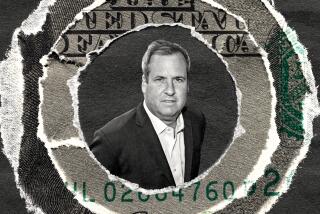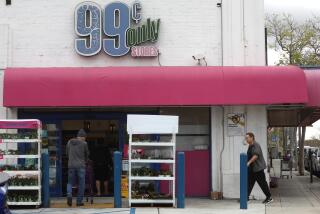Investors in Some of Market’s New Kids on Block Take Losses
- Share via
As the market for new stock issues starts to simmer again, maybe it’s a good time to look back at the 1990 batch of such deals . . . and whether investors made any money playing this high-stakes game.
The short answer: Some people did make very cool profits in new stocks last year. But in the national tally of the year’s most disastrous deals, Southland companies unfortunately are overrepresented.
To put it in hard money terms, some investors paid $8 to $12.50 a share for new L.A.-area stocks that plunged as low as $1 to $2 by the end of 1990. That isn’t supposed to happen, and it rightfully causes many individuals to shun the new-stock arena for fear of having their clocks cleaned.
Just how cautious investors may have become about new issues will be evident in the next few months. If the stock market stays reasonably strong, scores of companies will attempt to raise cash by going public. Many will be California-based technology companies, but the roster of wanna-be-public firms spans much more than the tech sector.
The lesson of 1990 is that investors shouldn’t be afraid to look over the new merchandise. But you will want to pick very carefully if you decide to open your wallet.
Of course, buying an initial public stock offering, or IPO, is always risky. By nature, companies selling stock for the first time generally are young firms with limited operating histories. You’re investing largely on faith in the new product or concept that the firm is trying to sell.
Even so, many investors buy IPOs assuming that they will be protected from a collapse in the stocks’ prices. The brokerages that sell these deals don’t promise that outright, but the “guarantee” somehow seems implicit. The sales pitch from broker to customer is heavy on the new company’s strengths and on the brokerage’s intention to stand behind the stock once it begins trading.
Yet last year, three Southland firms ended up on the year’s 10 Worst IPO list, as compiled by Standard & Poor’s Corp. While the average 1990 IPO was down 13% by year’s end as the bear market gripped Wall Street, the Southland companies on the 10 Worst list fell 70% or more:
* Digital Sound, a Carpinteria company that makes voice-mail equipment, sold shares at $8.50 each in February, 1990. By year-end, the price was at $1.50, for an 82% loss.
* Stor, a City of Industry-based chain of home furnishings stores, went public at $8 a share last April and ended the year at $1.28, for an 84% loss.
* Vidmark, a home video distributor based in San Monica, went public at $12.50 a share in June but finished the year at $3.75.
Meanwhile, in the latest such bomb, Perris, Calif.-based Modtech, which builds modular classrooms for school districts, saw its stock plunge to $7 from $11.75 last week after a surprisingly bad fourth-quarter earnings report. The company went public last July at $10 a share.
Was it just coincidence that these L.A.-area firms should perform so poorly out of 144 IPOs included in S&P;’s 1990 tally? Some investors may naturally wonder whether the brokerages that sponsored these stocks understood the businesses as well as they should have.
In the case of Stor, Vidmark and Modtech, the chief underwriters weren’t major Wall Street firms but rather were smaller, regional brokerages: Robertson Stephens of San Francisco and Bateman Eichler of Los Angeles handled Stor; Sutro & Co., whose corporate finance department is based in L.A., handled Vidmark, and L.A.-based Seidler Amdec handled Modtech.
The regional brokerages say any suggestion that they can’t do IPO deals as well as their larger brethren is pure bunk. Lloyd Greif, corporate finance chief at Sutro, notes that his firm was the lead underwriter of athletic shoe company L.A. Gear in 1986. L.A. Gear saw sales and earnings plunge last year, but from 1987 to 1990 it was one of the apparel industry’s hottest companies--and hottest stocks.
“A regional (brokerage) is as capable of doing ‘due diligence’ before a deal as any national firm,” Greif argues. “Due diligence” means the brokerage has every reason to believe that this is a fine investment.
In the case of Vidmark, Greif says, “we had the misfortune to come out right before the invasion (of Kuwait). The stock didn’t have the opportunity to find support.” But in addition, Greif admits, Vidmark was hit later in the year with competitive pressures in the video market that “the marketplace didn’t see coming.”
In Stor’s case, the company was “a victim of the credit crunch,” says Bateman’s corporate finance director, Thomas Hacking. The company’s plan to build stores was dependent on developers’ ability to get bank loans, he says. The extent of the 1990 credit crunch was unforeseeable a year ago, Hacking contends.
But he also admits that Bateman agreed to co-manage the Stor offering against one of its general underwriting rules: That a candidate IPO company must have annual after-tax profits of at least $1 million. In fact, Stor wasn’t profitable when it went public and still isn’t. Hacking says Bateman went for the deal despite the bottom-line losses because “every now and then a story is so good.” Stor, he maintains, “still is a good company and will do just fine” in the long run.
Whether the regional firms simply were unlucky--or sloppy--with these IPOs can be debated between now and doomsday. As hard as those stocks were hit, it’s also true that some of Wall Street’s biggest brokerages had their own private disasters. Goldman, Sachs & Co., for example, was the chief underwriter for the Digital Sound offering. Digital’s orders for voice-mail equipment plunged just a few months after the stock sale, and the firm is still struggling to rebuild its business one year later.
It’s also true that many IPOs of 1990 paid off handsomely: Pinkerton’s, the Van Nuys-based security firm, went public at $14 last April and now trades for $26.50; athletic-shoe firm K Swiss of Pacoima went public at $17.50 last June and now is at $21.75.
For investors in the IPO losers, the excuses don’t matter much now anyway because excuses won’t make their money come back. The benefit of IPO hindsight is that it helps other investors understand why all new stock issues have to be approached with caution and reason. If you don’t understand the business, don’t buy it, no matter how beautiful a broker’s sales pitch happens to be.
And if you buy, understand that there really is no implicit guarantee on the brokerage’s part to support the stock once it begins trading. While underwriters of IPOs generally stand ready to buy the stock on the open market to help keep the price up after the offering, if the business starts to go bad, the stock is going to sink--period.
1990’S NEW-STOCK DISASTERS These were the 10 biggest losers among initial public stock offerings (IPOs) that came to market last year. The boldfaced names are Southland companies.
IPO 1990 Pct. Tues. Stock price close chng. close In-Store Advt. $19.00 $2.44 -87% $4.63 STOR 8.00 1.28 -84% 1.25 Digital Sound 8.50 1.50 -82% 1.13 Crest Indus. 6.75 1.25 -81% 2.63 Club Theatre 5.00 1.00 -80% 1.88 Offshore Pipeline 17.00 4.88 -71% 9.13 Vidmark 12.50 3.75 -70% 5.00 IKOS Systems 6.50 2.19 -66% 2.50 Devlieg-Bullard 7.00 2.38 -66% 3.13 RMI Titanium 12.50 5.00 -60% 6.38
All stocks trade OTC except Offshore Pipeline and RMI (NYSE)
Source: Standard & Poor’s Corp.
More to Read
Inside the business of entertainment
The Wide Shot brings you news, analysis and insights on everything from streaming wars to production — and what it all means for the future.
You may occasionally receive promotional content from the Los Angeles Times.










